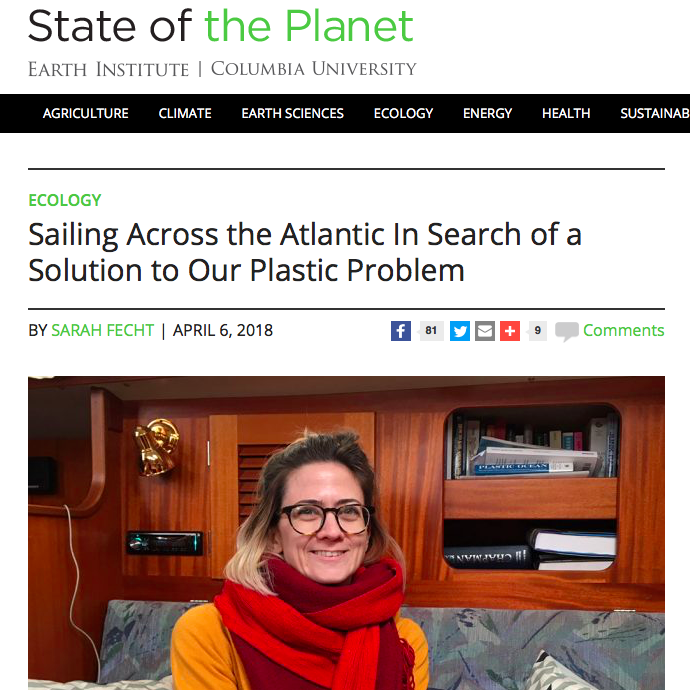EARTH INSTITUTE ABOARD FANKY
On a cold, gray day in March, Agustina Besada climbs down into the belly of Fanky the 37-foot sailboat. It’s cozy inside, though a bit stoop-inducing in some places.
Starting in just a few weeks, Besada and a small crew will spend two months living in this boat as they sail from New York to Portugal. Over the next two months, their mission is to explore where plastic pollution comes from, where it ends up, and how our society can fix its broken relationship with this persistent polymer.
“I’ve always felt obsessed with plastic,” explains Besada. After graduating from Columbia University’s Sustainability Management (SUMA) program and the Columbia Business School, she has worked primarily in waste management and recycling. She says that seeing the massive amounts of plastic that people discard every day was one inspiration for the plastic pilgrimage, dubbed “UnPlastify.”
Along the journey, Besada will be collecting samples for research on plastic pollution for the 5Gyres Institute. She’ll also be blogging, interviewing experts, and contemplating many questions. How is it that humanity came to have this relationship with plastic? What are other people doing to fix it? What does plastic pollution in the ocean actually look like? Besada hopes others will submit their questions and participate in the exploration as well.
“I can read reports and make my conclusions,” she says, “but I really wanted to experience this and share my journey and my questions and my findings.”
Plastic, Plastic Everywhere
Besada isn’t advocating that we eradicate plastic from our lives. That would be extremely difficult. “But I do think we need to rethink this relationship with plastic,” she says. “It is too much. We are too dependent on each other. We need to take a break, and think about how can we have a healthier relationship?”
The first step, she says, is realizing that we have a problem. You may use a water bottle or a plastic straw for a few minutes, but these items linger in landfills and the environment for centuries. “Once you realize that, it’s very difficult to not do anything,” says Besada.
It isn’t enough to simply recycle. Many items—like straws and food wrappers—are very difficult to recycle. And a large portion of recyclable plastics get sent to landfills anyway. Plus, items made from recycled plastic are usually not recyclable themselves, so there’s a limit to how many times we can reuse them.
One of the biggest and easiest ways to help is to do your best to avoid single-use plastics. Some suggestions:
Fill up your reusable water bottle before leaving home
Carry a cloth shopping bag in your purse, car trunk, or backpack
Bring your own Tupperware for restaurant leftovers
Resist the urge to use plastic lids or straws with your beverages
Buy other items that have been made from recycled plastic, to increase demand for items that aren’t made from virgin plastic.
“There’s no to-do list that works for everyone. What plastic can you eliminate from your life?” Besada asks.
Over the long-term, she hopes to find ways to create a circular plastic economy.
Being Prepared
Besada’s training through the Earth Institute is helping her as she designs the framework for her Unplastify interviews, data collection, and analysis.
“Something you learn at SUMA is that you need to measure, you need to quantify, you need to understand what the problem is in order to do something,” she says. “Having this process in mind for the development of the project, and working with a scientific approach, that’s something that I definitely got from the program.”
She’s also had to pick up a few new skills.
“I’m getting to be an expert in plumbing,” she says, “and getting parts, fixing things.” At the stern of the ship, tools and washers are strewn about where she’s fixing the rudder. Then there are engine repairs—she’s the only one on the crew small enough to fit into the tiny engine room—and learning about safety, navigation, and the weather.
Despite the multitude of tasks to finish, the team is on track to set sail in mid-April. From New Jersey, they’ll sail to Virginia to meet up with a rally of other boats following the same passage across the Atlantic. In the coming weeks, they’ll stop in Bermuda and the Azores, before arriving in Portugal in mid-June.
Then, for Phase 2, they’ll sail through Europe, adapting and improving on their study design. The journey will come to an end in November, after which the team will present the results of their exploration.
You can follow their journey on the Unplastify blog, as well as Instagram, Facebook, and Twitter.

